The global screw compressor market is valued at USD 16.4 billion in 2025 and is projected to reach USD 22.9 billion by 2035, representing an absolute increase of USD 6.5 billion over the forecast period. As per Future Market Insights, delivering insights for Fortune 1000 firms globally, this translates into a total growth of 39.5%, with the market forecast to expand at a compound annual growth rate (CAGR) of 3.4% between 2025 and 2035.
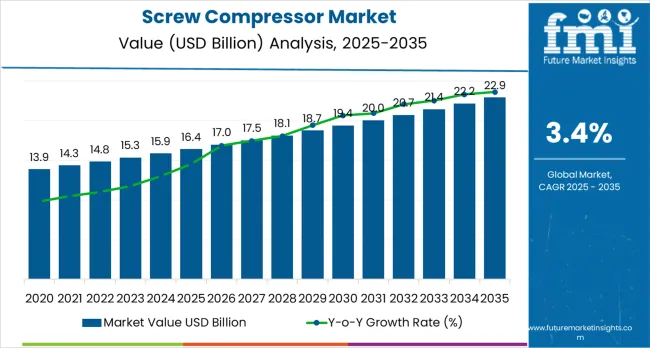
The market size is expected to grow by nearly 1.4X during the same period, supported by increasing demand for energy-efficient solutions, growing industrial automation, and rising adoption of advanced compression technologies across diverse manufacturing, oil and gas, and chemical processing applications.
Between 2025 and 2030, the screw compressor market is projected to expand from USD 16.4 billion to USD 19.32 billion, resulting in a value increase of USD 2.96 billion, which represents 45.8% of the total forecast growth for the decade. This phase of development will be shaped by increasing industrial automation, rising energy efficiency requirements, and growing adoption of IoT-enabled compressor systems in manufacturing and processing applications. Equipment manufacturers are expanding their production capabilities to address the growing demand for efficient compression solutions and enhanced operational reliability.
The HVAC and refrigeration market is the primary driver, accounting for approximately 35-40% of the market. Screw compressors are widely used in air conditioning and refrigeration systems due to their energy efficiency, reliability, and ability to handle large volumes of air.
These compressors are integral to both residential and commercial HVAC systems, providing cooling and temperature regulation. The industrial machinery and equipment market contributes around 25-30%. In manufacturing facilities, screw compressors are used for powering pneumatic tools, air dryers, and material handling systems, where consistent and efficient air supply is essential for smooth operations.
The oil and gas market plays a significant role in the screw compressor market, contributing about 15-18%. Screw compressors are critical in offshore and onshore oil and gas applications, where they are used for gas compression, pipeline transportation, and to provide compressed air for drilling and production operations.
The automotive market accounts for roughly 10-12%, driven by the increasing demand for efficient compressors in vehicle air conditioning systems, particularly in electric and hybrid vehicles, where energy efficiency is a key concern. The chemical and pharmaceutical market contributes approximately 5-8%, as screw compressors are essential for providing air to pneumatic systems in chemical production, pharmaceutical manufacturing, and other sensitive processes.
| Metric | Value |
|---|---|
| Estimated Value in (2025E) | USD 16.4 billion |
| Forecast Value in (2035F) | USD 22.9 billion |
| Forecast CAGR (2025 to 2035) | 3.4% |
Market expansion is being supported by the increasing demand for energy-efficient compression solutions and the corresponding need for reliable equipment that can maintain operational performance and cost-effectiveness while supporting diverse industrial applications across various manufacturing, oil and gas, and chemical processing environments.
Modern industrial operators and facility managers are increasingly focused on implementing compressor solutions that can reduce energy consumption, minimize operational costs, and provide consistent performance in compression operations. Screw compressors'proven ability to deliver enhanced operational efficiency, reliable compression capabilities, and versatile industrial applications make them essential equipment for contemporary manufacturing operations and process industry solutions.
The growing emphasis on industrial automation and energy efficiency is driving demand for screw compressors that can support high-volume operations, reduce energy consumption, and enable efficient compressed air management across varying industrial configurations.
Industrial operators'preference for equipment that combines reliability with operational efficiency and cost-effectiveness is creating opportunities for innovative compression implementations. The rising influence of environmental regulations and smart manufacturing technologies is also contributing to increased adoption of screw compressors that can provide advanced operational control without compromising performance or energy efficiency.
The screw compressor market is poised for robust growth and transformation. As industrial operators and facility managers across both developed and emerging markets seek compression equipment that is efficient, reliable, automated, and environmentally compliant, screw compressor systems are gaining prominence not just as operational equipment but as strategic infrastructure for operational efficiency, energy management, process optimization enhancement, and environmental compliance.
Rising industrialization and automation demand in North America, Europe, and Asia Pacific amplify demand, while manufacturers are picking up on innovations in variable speed technology and digital control systems.
Pathways like smart technology integration, energy efficiency improvements, and environmental compliance promise strong margin uplift, especially in developed markets. Geographic expansion and application diversification will capture volume, particularly where industrial activity is growing or process requirements require modernization. Environmental pressures around energy efficiency, emission reduction, operational optimization, and regulatory compliance give structural support.
The market is segmented by type, technology, stage, driver type, capacity, end-use, and region. By type, the market is divided into belt drive and gear drive. By technology, it covers stationary (oil lubricated, oil-free) and portable (oil lubricated, oil-free). By stage, it includes single stage, two-stage, and multi-stage.
By driver type, it is segmented into liquid driven, gas driven, and electric. By capacity, it covers up to 5HP, 5 to 50HP, 50 to 250HP, and above 250HP. By end-use, it includes oil and gas industry, chemical industry, energy and transmission, automotive and aerospace, mining and minerals, and other manufacturing industry. Regionally, the market is divided into North America, Latin America, Europe, East Asia, South Asia, Oceania, and Middle East &Africa.
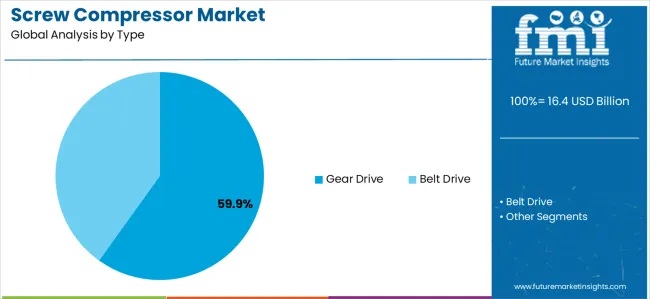
The gear drive segment is projected to account for 59.9% of the screw compressor market in 2025, reaffirming its position as the leading type category. Industrial operators and facility managers increasingly utilize gear drive compressors for their proven reliability, superior performance, and energy efficiency in industrial applications across manufacturing, oil and gas, and chemical processing operations. Gear drive technology's established operational procedures and consistent performance output directly address the industrial requirements for reliable compression and operational efficiency in diverse manufacturing environments.
This type segment forms the foundation of current industrial compression operations, as it represents the technology with the greatest operational efficiency and established maintenance infrastructure across multiple applications and industrial scenarios. Operator investments in enhanced precision control systems and energy optimization continue to strengthen adoption among industrial operators and facility managers. With operators prioritizing operational reliability and equipment availability, gear drive compressors align with both operational efficiency objectives and cost management requirements, making them the central component of comprehensive compression strategies.
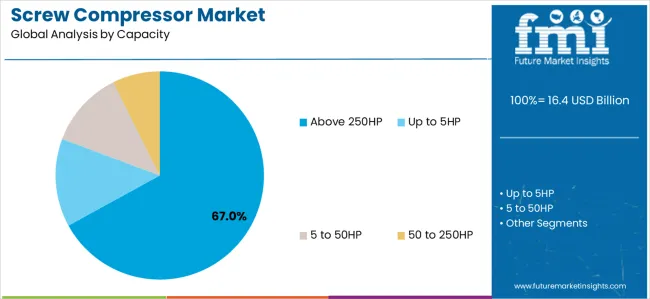
Above 250HP capacity is projected to represent 67% of screw compressor demand in 2025, underscoring its critical role as the primary capacity range for large-scale industrial and heavy-duty manufacturing applications. Industrial operators prefer compressors in this capacity range for their efficiency, reliability, and ability to handle high-demand operations while supporting large-scale manufacturing and industrial processing requirements. Positioned as essential equipment for modern industrial operations, high-capacity compressors offer both operational advantages and performance benefits.
The segment is supported by continuous innovation in industrial expansion and the growing availability of specialized equipment configurations that enable efficient compression with enhanced operational capabilities. The industrial operators are investing in capacity optimization to support large-scale operations and manufacturing delivery. As industrial development becomes more prevalent and operational requirements increase, above 250HP capacity will continue to dominate the capacity market while supporting advanced equipment utilization and industrial compression strategies.
The screw compressor market is advancing steadily due to increasing demand for energy-efficient compression solutions and growing adoption of automation infrastructure that provides enhanced operational efficiency and process reliability across diverse industrial applications. The market faces challenges, including high equipment capital costs, specialized maintenance requirements, and varying operational demands across different industrial environments. Innovation in variable speed technology and smart control systems continues to influence equipment development and market expansion patterns.
The growing expansion of industrial automation and energy efficiency regulations is enabling equipment manufacturers to develop screw compressor systems that provide superior operational efficiency, enhanced energy management capabilities, and reliable performance in high-demand industrial environments. Advanced compressor systems provide improved energy efficiency while allowing more effective compression control and consistent performance delivery across various applications and industrial requirements. Manufacturers are increasingly recognizing the competitive advantages of modern compressor capabilities for operational efficiency and energy management positioning.
Modern screw compressor manufacturers are incorporating IoT connectivity and predictive maintenance systems to enhance operational efficiency, reduce downtime, and ensure consistent performance delivery to industrial operators. These technologies improve operational reliability while enabling new applications, including remote monitoring and automated maintenance solutions. Advanced technology integration also allows manufacturers to support premium equipment positioning and operational optimization beyond traditional compression equipment supply.
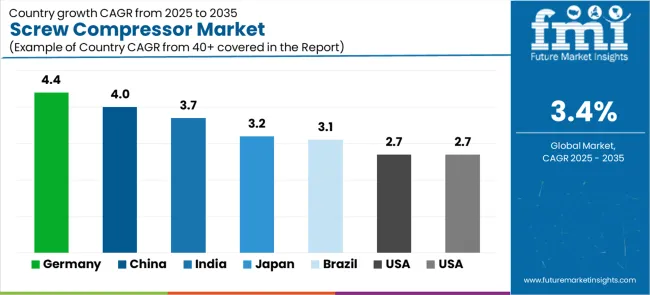
| Country | CAGR (2025-2035) |
|---|---|
| USA | 2.7% |
| China | 4.0% |
| Germany | 4.4% |
| India | 3.7% |
| Australia | 2.7% |
| Japan | 3.2% |
| Brazil | 3.1% |
The screw compressor market is experiencing steady growth globally, with Germany leading at a 4.4% CAGR through 2035, driven by advanced automation industry development, comprehensive manufacturing capabilities, and significant adoption of energy-efficient compression solutions. China follows at 4.0%, supported by massive industrial development projects, technological advancement initiatives, and growing adoption of smart compressor technologies. India shows growth at 3.7%, emphasizing rapid industrialization and manufacturing expansion.
Japan demonstrates 3.2% growth, focusing on technological innovation and operational efficiency optimization. Brazil records 3.1%, supporting industrial development and infrastructure modernization. USA shows 2.7% growth, driven by industrial automation and energy efficiency requirements. Australia demonstrates 2.7% growth, supported by mining industry development but constrained by market maturity.
The report covers an in-depth analysis of 40+ countries with top-performing countries are highlighted below.
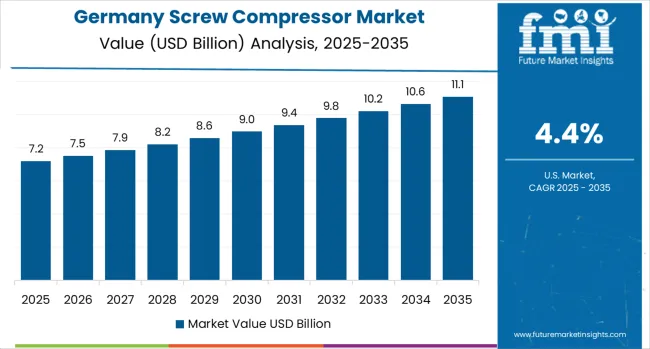
Revenue from screw compressors in Germany is projected to exhibit exceptional growth with a CAGR of 4.4% through 2035, driven by advanced automation industry development and comprehensive manufacturing capabilities supported by energy efficiency initiatives and operational excellence programs. The country's sophisticated industrial infrastructure and increasing investment in automation technologies are creating substantial demand for advanced compression solutions. Major industrial operators and manufacturing companies are establishing comprehensive compressor operations to serve both domestic manufacturing needs and export market requirements.
Demand for screw compressors in China is expanding at a CAGR of 4.0%, supported by the country's massive industrial development projects, comprehensive technological advancement programs, and increasing adoption of smart compressor systems. The country's strategic industrial modernization and growing manufacturing sophistication are driving demand for advanced compression capabilities. State enterprises and manufacturing companies are establishing extensive equipment operations to address the growing demand for efficient compression and operational reliability.
Revenue from screw compressors in India is growing at a CAGR of 3.7%, supported by the country's rapid industrialization programs, increasing manufacturing expansion, and strategic investment in industrial development. India's growing industrial market and emphasis on operational efficiency are driving demand for cost-effective compression technologies across major industrial markets. Manufacturing operators and industrial facilities are establishing equipment partnerships to serve both domestic industrial expansion and operational efficiency requirements.
Demand for screw compressors in the USA is expected to expand at a CAGR of 2.7%, supported by the country's industrial automation initiatives, energy efficiency requirements, and strategic investment in manufacturing modernization. USA's established industrial sector and emphasis on operational optimization are driving demand for high-performance compression technologies across major manufacturing markets. Industrial operators and facility managers are establishing technology partnerships to serve both domestic manufacturing needs and operational efficiency markets.
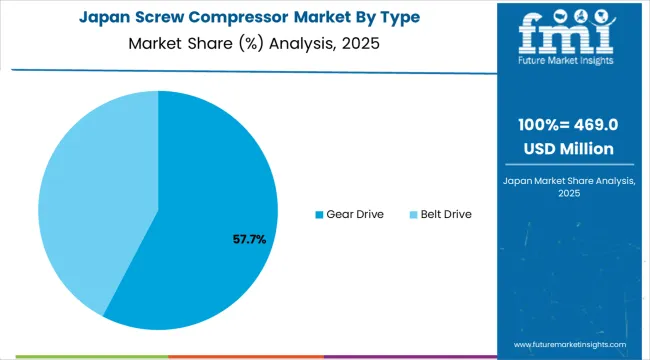
Revenue from screw compressors in Japan is forecasted to grow at a CAGR of 3.2%, supported by the country's technology innovation capabilities, manufacturing excellence standards, and strategic investment in operational efficiency improvement. Japan's advanced industrial sector and emphasis on quality optimization are driving demand for high-technology compression systems across major manufacturing markets. Industrial operators and facility managers are establishing technology partnerships to serve both domestic manufacturing development and international competitiveness markets.
Revenue from screw compressors in Australia is expanding at a CAGR of 2.7%, supported by the country's mining industry development, infrastructure modernization programs, and strategic investment in operational efficiency enhancement. Australia's established mining sector and emphasis on operational optimization are supporting demand for reliable compression technologies across major industrial markets. Mining operators and industrial facilities are establishing equipment programs to serve both domestic mining needs and infrastructure development requirements.
Demand for screw compressors in Brazil is anticipated to grow at a CAGR of 3.1%, supported by the country's industrial development programs, growing manufacturing expansion, and increasing investment in operational modernization. Brazil's expanding industrial market and emphasis on operational improvement are driving demand for cost-effective compression technologies across major manufacturing markets. Industrial operators and manufacturing companies are establishing service partnerships to serve both domestic industrial development and operational efficiency markets.
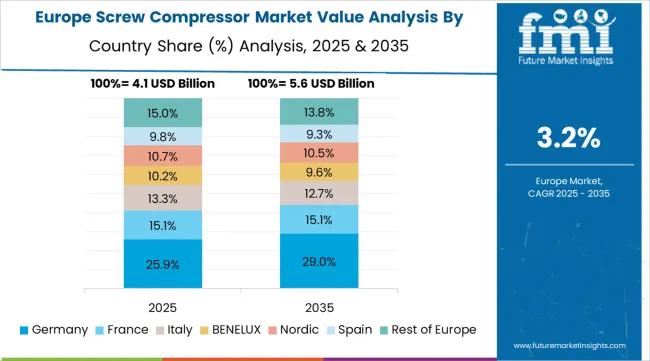
The screw compressor market in Europe is projected to grow from USD 4.2 billion in 2025 to USD 5.8 billion by 2035, registering a CAGR of 3.3% over the forecast period. Germany is expected to maintain its leadership position with a 29.1% market share in 2025, increasing to 29.4% by 2035, supported by its advanced manufacturing infrastructure, comprehensive automation capabilities, and major industrial facilities serving European and international markets.
France follows with an 18.6% share in 2025, projected to ease to 18.3% by 2035, driven by industrial modernization programs, manufacturing development initiatives, and established industrial capabilities, but facing challenges from competitive pressures and investment constraints. United Kingdom holds a 15.7% share in 2025, expected to decline to 15.4% by 2035, supported by industrial modernization requirements and automation development initiatives but facing challenges from post-Brexit adjustments and investment uncertainties.
Italy commands a 14.9% share in 2025, projected to reach 15.0% by 2035, while Spain accounts for 12.1% in 2025, expected to reach 12.2% by 2035. The Rest of Europe region, including Nordic countries, Eastern European markets, Netherlands, Belgium, and other European countries, is anticipated to gain momentum, expanding its collective share from 9.6% to 9.7% by 2035, attributed to increasing industrial development across Nordic countries and growing manufacturing modernization across various European markets implementing automation programs.

The screw compressor market is characterized by competition among established compression equipment manufacturers, specialized compressor technology providers, and integrated industrial solution companies. Companies are investing in variable speed drive research, smart technology development, IoT integration capabilities, and comprehensive equipment portfolios to deliver efficient, reliable, and environmentally compliant screw compressor solutions. Innovation in energy efficiency systems, predictive maintenance technologies, and digital monitoring capabilities is central to strengthening market position and competitive advantage.
Atlas Copco leads the market with a strong presence, offering comprehensive compressor solutions with a focus on reliability and advanced technology for industrial applications. Hitachi provides integrated industrial systems with an emphasis on operational efficiency and automation capabilities. Ingersoll Rand delivers advanced compression technologies with a focus on energy efficiency and smart controls. Emerson Electric Co. specializes in industrial automation solutions with emphasis on system integration and performance optimization.
Daikin Industries Ltd. focuses on comprehensive industrial equipment with global service networks and energy-efficient technologies. Siemens offers integrated automation systems with emphasis on digitalization and Industry 4.0 capabilities. IHI Rotating Machinery provides specialized rotating equipment with focus on reliability and performance optimization. KAESER delivers comprehensive compressor solutions with emphasis on energy management and operational efficiency.
| Items | Values |
|---|---|
| Quantitative Units (2025) | USD 16.4 billion |
| Type | Belt Drive, Gear Drive |
| Technology | Stationary (Oil Lubricated, Oil-Free), Portable (Oil Lubricated, Oil-Free) |
| Stage | Single Stage, Two-Stage, Multi-Stage |
| Driver Type | Liquid Driven, Gas Driven, Electric |
| Capacity | Up to 5HP, 5 to 50HP, 50 to 250HP, Above 250HP |
| End-Use | Oil and Gas Industry, Chemical Industry, Energy and Transmission, Automotive and Aerospace, Mining and Minerals, Other Manufacturing Industry |
| Regions Covered | North America, Latin America, Europe, East Asia, South Asia, Oceania, Middle East &Africa |
| Countries Covered | United States, Canada, Germany, United Kingdom, France, China, Japan, Brazil, India and 40+ countries |
| Key Companies Profiled | Atlas Copco, Hitachi, Ingersoll Rand, Emerson Electric Co., Daikin Industries Ltd., Siemens, IHI Rotating Machinery, and KAESER |
| Additional Attributes | Equipment sales by type and capacity, regional demand trends, competitive landscape, technological advancements in variable speed systems, smart technology development, IoT integration innovation, and operational efficiency optimization |
The global screw compressor market is estimated to be valued at USD 16.4 billion in 2025.
The market size for the screw compressor market is projected to reach USD 22.9 billion by 2035.
The screw compressor market is expected to grow at a 3.4% CAGR between 2025 and 2035.
The key product types in screw compressor market are gear drive and belt drive.
In terms of capacity, above 250hp segment to command 67.0% share in the screw compressor market in 2025.






Full Research Suite comprises of:
Market outlook & trends analysis
Interviews & case studies
Strategic recommendations
Vendor profiles & capabilities analysis
5-year forecasts
8 regions and 60+ country-level data splits
Market segment data splits
12 months of continuous data updates
DELIVERED AS:
PDF EXCEL ONLINE
Screw Conveyor Market Size and Share Forecast Outlook 2025 to 2035
Screw Capping Machine Market Size and Share Forecast Outlook 2025 to 2035
Screwdriver Market Size and Share Forecast Outlook 2025 to 2035
Screw Top Jar Market Insight - Growth & Trends to 2025 to 2025
Key Players & Market Share in Screw Conveyor Industry
Screw Air End Market Growth – Trends & Forecast 2024-2034
Screw Jacks Market
Screw Top Lids Market
Screw Top Pails Market
Leadscrew Market
Twin Screw Extruders Market Size and Share Forecast Outlook 2025 to 2035
Pipe Screw Extruder Market Analysis - Size, Share, and Forecast Outlook 2025 to 2035
Bone Screw System Market Growth – Demand, Trends & Industry Forecast 2024-2034
Ball screw Market
Single Screw Extruder Market Size and Share Forecast Outlook 2025 to 2035
Pedicle Screw Positioning Market Analysis - Size, Share, and Forecast Outlook 2025 to 2035
Pedicle Screw Systems Market - Growth & Forecast 2025 to 2035
Electric Corkscrew Market
Polypropylene Screw Caps Market
Structural Wood Screws Market Size and Share Forecast Outlook 2025 to 2035

Thank you!
You will receive an email from our Business Development Manager. Please be sure to check your SPAM/JUNK folder too.
Chat With
MaRIA